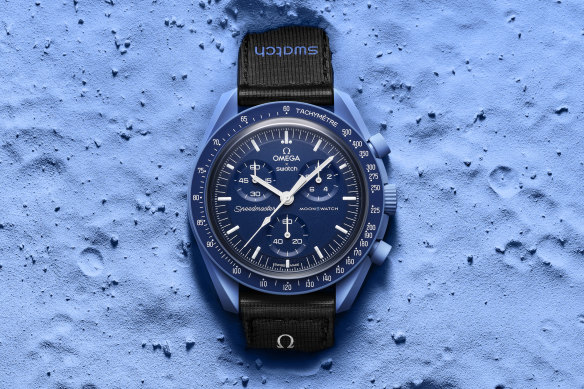By Luke Benedictus
It’s early March and I’m in a taxi zipping through the placid streets of Geneva. In the front seat is Patrick Stewart. No, not the actor. This guy is merely the global commercial director of the Australian watch retailer Kennedy. Not that Stewart is complaining. As the taxi rolls past the lake, he confides that business is booming, a US expansion is imminent and Kennedy is sponsoring the AFL. “Last year was our best year ever,” he says.

The Bioceramic MoonSwatch is a tribute to the Omega Speedmaster Professional, the first watch to be worn on the moon.
Admittedly, men in such positions are prone to talking a good game. But this buoyancy was echoed by the CEO of Watches of Switzerland, Hugh Duffy, who declared demand was “off the scale” for Rolex, Patek Philippe and Audemars Piguet, and had now spread to other brands including Cartier, Tudor, Breitling, TAG Heuer and Omega.
It’s not just the top end of town, either. In March, Swatch collaborated with Omega to release the Bioceramic MoonSwatch. This was Swatch’s quartz-powered tribute to the Omega Speedmaster Professional, the first watch to be worn on the moon, and retailed for a modest $380. But your chances of wrangling a MoonSwatch were slim. Despite the watch not being a limited edition, it was only made available at 110 Swatch stores around the world.
Aware that demand would massively outstrip supply, eager punters camped outside in Sydney’s Pitt Street Mall overnight, while in Melbourne’s Chadstone the allocation was snapped up in under 10 minutes and police were called to subdue a reported crowd of 2000. In New York, rumours swirled of someone being stabbed for their MoonSwatch outside a SoHo shop.
Even allowing for the madness of crowds, the hysteria engulfing the humble wristwatch feels unlikely. With its basic time-telling function now superseded by our phones, you might expect watches to be on the brink of extinction, like wind-up car windows or public decency. That the opposite is true comes partly down to the pandemic. With holiday and entertainment opportunities curtailed by lockdowns, discretionary spending habits shifted in moneyed circles, with the watch industry a beneficiary.

In Melbourne, the release of the MoonSwatch saw the allocation snapped up in under 10 minutes while police were called to subdue a reported crowd of 2000.Credit: @chronoandothergoodstuff/Instagram
Yet the groundwork for this boom was done in the preceding years as the world awoke to the idea of the timepiece as asset. In 2017, a steel Rolex Daytona that had belonged to the actor Paul Newman sold at auction for $US17.8 million (nearly $25 million). The investment potential of certain watches became clear.
Today, the retail value of a coveted watch model can multiply at a preposterous rate. Which is why, at the time of writing, there are more than 1000 second-hand MoonSwatches for sale on the Chrono24 website at savagely inflated prices. For many of those who queued up, it would seem, the purchase ended up being less about time than money.
To read more from Good Weekend magazine, visit our page at The Sydney Morning Herald, The Age and Brisbane Times.